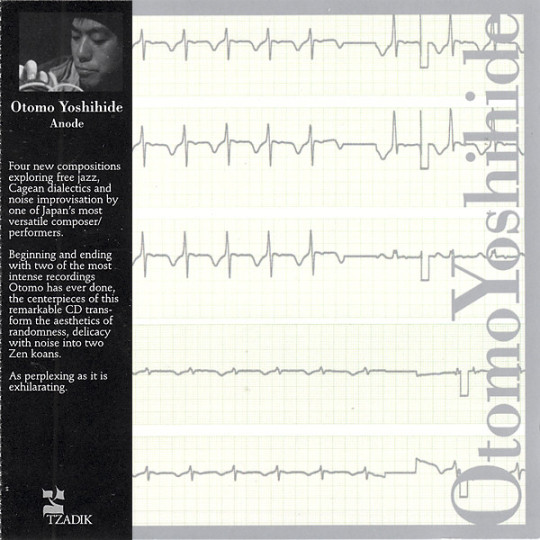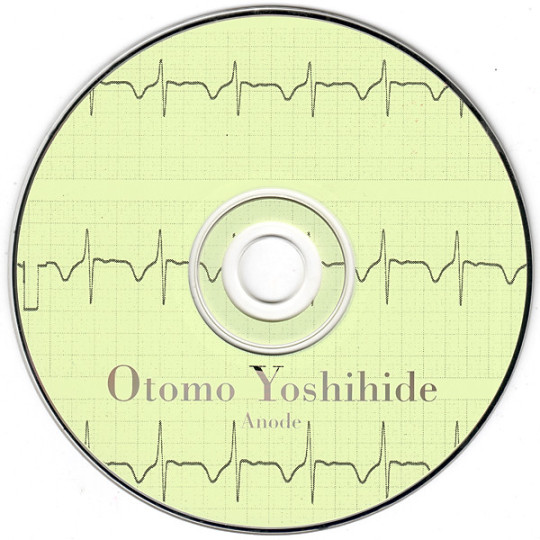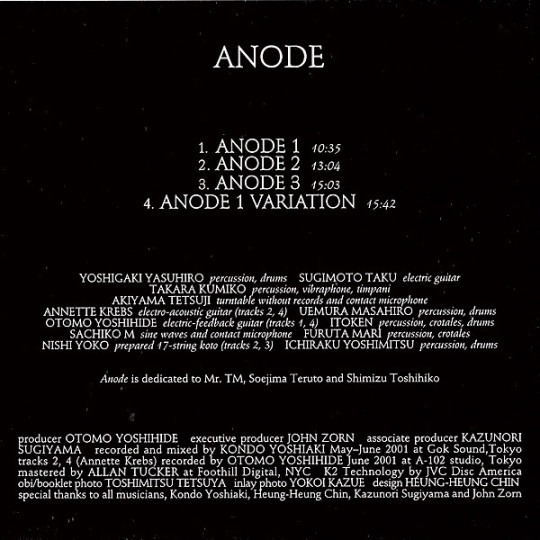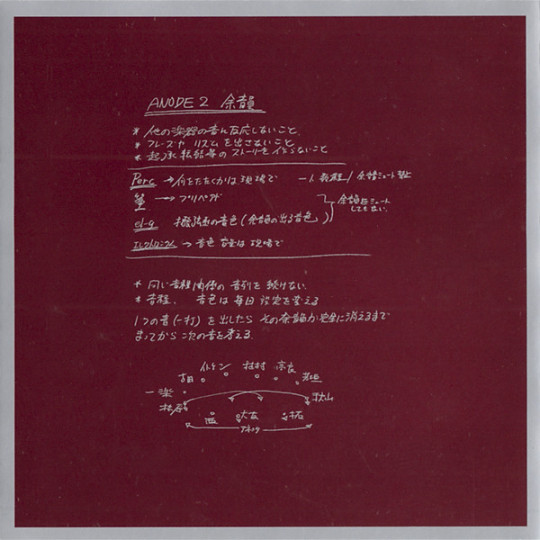#sugimoto taku
Explore tagged Tumblr posts
Text








otomo yoshihide "anode"
tzadik 2001
scans from discogs
#noise music#experimental music#free improvisation#otomo yoshihide#tzadik#john zorn#composer series#new music#sachiko m#sugimoto taku#architecture#album art#cd art#compact disc#heung-heung chin
3 notes
·
View notes
Text
youtube
taku sugimoto -- improvisation
5 notes
·
View notes
Text
youtube
Tetuzi Akiyama & Taku Sugimoto
Hanegi Park April 11, 2023
17 notes
·
View notes
Text
youtube
love this composition. really curious how this is notated.
2 notes
·
View notes
Text
"If we define a particular sound that has a particular pitch as the sound that contains a corresponding frequency, we can mathematically prove the fact that (for example) a C note can be in harmony with an E note and a G note by comparing the frequencies of the three. This data can be trusted in regard to the consonance of sounds, but when perceiving consonance phenomena as sensuous impressions, can this sensuous value be absolute? Conceivably, the fact that the notes C, E and G are consonant with each other could be an incidental event. There might have been a chance that these three notes would not be regarded as the consonant sounds or a chord or the sounds with pitches. There might also have been a possible chance that some completely different set of notes - whatever it was - became the consonant sounds, which could have been proved to be consonant mathematically by means of some different method (or could be the same method in a narrow sense) of reading the frequencies. If that had happened, the music would be a completely different form as it is now. Perhaps within the possibilities, some new form of expression that is not regarded as music today could be included, and it might not be impossible to perform a stunt to aggressively insist that this is music. But in order to justify this statement, we need a common concept on what can be defined as music as an initial premise. In fact, the notes C, E and G are considered to be consonant sounds in the premise we share today, and the other sets of notes that have no relation with each other do not gain important positions in today's world of consonant sounds. That is because any thought experiment regarding music has to be carried out using the foundation of the present situation of music. On the other hand, the aggressive statement, to insist that some form of expression can be regarded as music even when it seems far away from the conventional form of music, naturally derives from the current situation surrounding the music. It should be possible enough to recognize a particular sound as something different from how it was identified in the past."
— Taku Sugimoto, A Philosophical Approach to Silence (tr. Yuko Zama)
4 notes
·
View notes
Audio


Pokkén Tournament - Magikarp Festival
#reblog#audio#music#my playlist#hiroki hashimoto#hiroyuki kawada#rio hamamoto#taku inoue#eriko sakurai#yoshinori hirai#takafumi sato#mitsuhiro kitadani#yu sugimoto#shota kageyama#magikarp festival#pokémon#pokkén tournament
3K notes
·
View notes
Text
8952
No one records my ad infinitum what i am trying to pull away what permits my materiality pins down my tongue my captors fly their nets i swear it i saw it the silent subjecting its saber x makes cheap.

View On WordPress
0 notes
Text
WHO ELSE HAS BEEN HYPE FOR THE MVC COLLECTION ON SWITCH?! I've been hyperfocusing on this high energy fighting game house nonstop music mix for the past four days and I'm SUPER excited to share this with everyone! no matter your play level these tracks will get you MOVING!!
anyway, this is a track from the mix now on soundcloud and youtube!!
https://on.soundcloud.com/hfJFU1GMtixHPmGK8
#MvC#MvC2#Pokken#Pokemon#Tekken#Street Fighter#BlazBlue#MeltyBlood#Bloody Roar#Killer Instinct#Tatsunoko#Legend of Legaia#Kaytranada#Victoria Monet#Charli xcx
11 notes
·
View notes
Text


Taku Sugimoto Onkyo Botched Assassination Burger🥂
10 notes
·
View notes
Text
youtube
Minami Saeki - glico (version for voice and tenor guitar) (2023)
composed by Minami Saeki
Minami Saeki: voice
Taku Sugimoto: tenor guitar
June 3, 2023 Izumi-Tamagawa, Tokyo
2 notes
·
View notes
Text

Chance Encounters #012
https://www.mixcloud.com/thomasmartinnutt/
Alexandra Spence, Christian Mirande, Dau, Sean McCann, Stuart Dempster, N.Racker, Kim Cascone, Danny McCarthy, Li Jianhong, Lyn Hejinian, Nuno Canavarro, Burkhard Stangl and Taku Sugimoto, Hans Abrahamsen, Steven Ball, Jon Hassell, Utah Kawasaki, Toshimaru Nakamura & Tetuzi Akiyama, Rubbish Music, Natasha Barrett, Jaspal Singh Bhogal, Roj and Wolfram Wire, Eliane Radigue, Jan Bang & Erik Honore, Erkki Kurenniemi, Liima, Intersystems, Alvin Curran, The Beatles, Lieutenant Caramel, Wyndham Lewis, Zenker Brothers, Soundwalk Collective, Sherwood & Pinch, Surgeon, Andy Fairley
5 notes
·
View notes
Text
"Is an E note more special than a D note? Is the start-up sound of a computer more interesting than the sound of rain? If it were possible for us to hear sound in such a simple manner, any of these sounds would not be more than any other sound. When we listen to a series of sounds, aren't we evaluating the information each sound delivers in relation with other elements? I think that every sound - like an E note, the start-up sound of a computer or the sound of rain - obtains a nature as a unique sound by its relations with each other."
— Taku Sugimoto, A Philosophical Approach to Silence (tr. Yuko Zama)
1 note
·
View note
Text
24-November 散財記録
04(mon) ・daynim / In Your Bad Day (2024, 7inch) ・Georgia + Dove / Air from Air (2023, LP) ・The Recyclers / Morceaux Choisis (1997, used LP) ・idyllic records compilation "New Chapter" (1995, used 2LP) ・Henri Texier Quartet Invite / Invites Joe Lovano / "Paris-Batignolles" (1986, used LP) ・Alcides Neves / Des (Trambelhar) Ou Não (1983, LP) ・Russ Garcia / I'll Never Forget What's Her Name (1956, used LP) ・Ada Moore / Jazz Workshop Volume Three (1955, used LP) 09(sat) ・孤独のヒュード / Shenandoah (2024, CD) ・Daniel Goyone / 2 (1986, used LP) ・Oregon / Crossing (1985, used LP) ・Egberto Gismonti / Sol Do Meio Dia (1978, used LP) ・蕉林喜雨 = Welcome Rain In The Banana Grove (?, used 10inch) ・民族器乐曲:喜看麦田千层浪 = Wave Upon Wave Of Golden Wheat - Folk Instrumentals (?, used 10inch) 11(mon) ・田上碧 / きらきらするすべて (2024, CD) 12(tue) ・Torn Hawk / Let's Cry and Do Pushups at the Same Time (2014, used LP) ・Klimek / Listen, The Snow Is Falling (2005, used 12inch) ・Edward Ball / Edward Ball's L'Orange Mechanik (1989, used LP) ・The Busy Drone / Mechanical Organ (1981, used LP+7inch) ・Anthony Davis & Jay Hoggard / Under the Double Moon (1981, used LP) ・Miriam Makeba / Pata Pata (1967, used 7inch) 16(sat) ��San Ignacio / La Identidad Es Una Trampa (2020, used LP) ・Cured Pink / '11 Put Aside (2014, used 12inch) ・Multiphonic Ensemble vs. Bisk (1997, used 12inch) ・Ulrich Gumpert / 'N Tango Für Gitti (Ulrich Gumpert Solo) (1986, used LP) ・Chick Corea / Tap Step (1980, used LP) ・Carmen Cavallaro and His Orchestra / The Uncollected Carmen Cavallaro, 1946 (1977, used LP) 17(sun) ・The Olivia Tremor Control / The Opera House (1996, used 2x7inch) ・Snapshot / Do the Love Magic! remix+original (1996, used 7inch) ・Hatfield and the North / Hatfield and the North (1974, used LP) 23(sat) ・みみのこと / 猫は夜中に散歩する (2024, cassette) 24(sun) ・Charles Hayward / Anonymous Bash (2014, used LP) ・Ladies Who Lunch / Everybody's Happy Nowadays (1997, used 7inch) ・Eugene Chadbourne / Corpses of Foreign War (1986, used LP) 27(wed) ・The Happy End / Turn Things Upside Down (1990, used LP) 30(sat) ・Taku Sugimoto / Since 2016 (2024, used LP) ・Luis / 057 (Schwyn) (2022, used 12inch) ・Cibo Matto / Super Relax (1997, used 12inch)
0 notes
